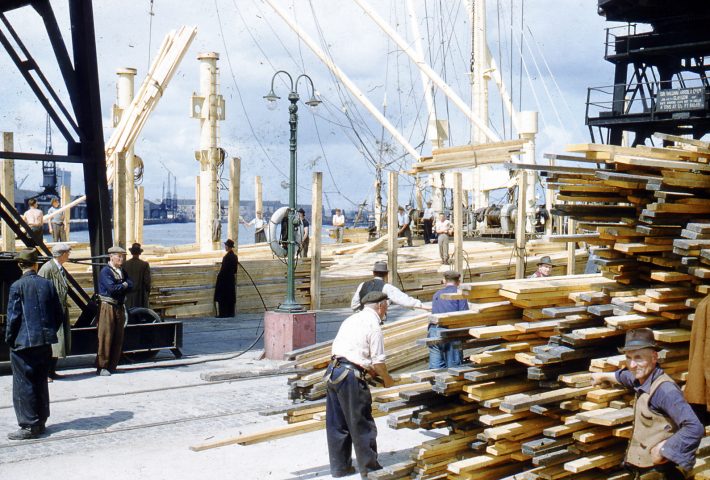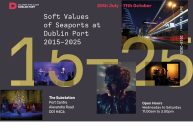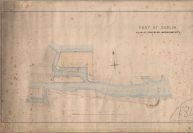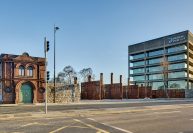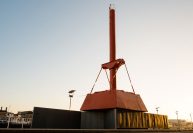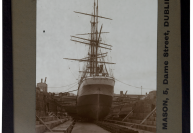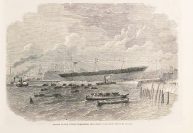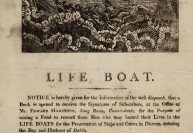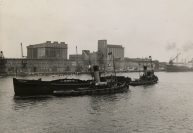Diving Into the Past
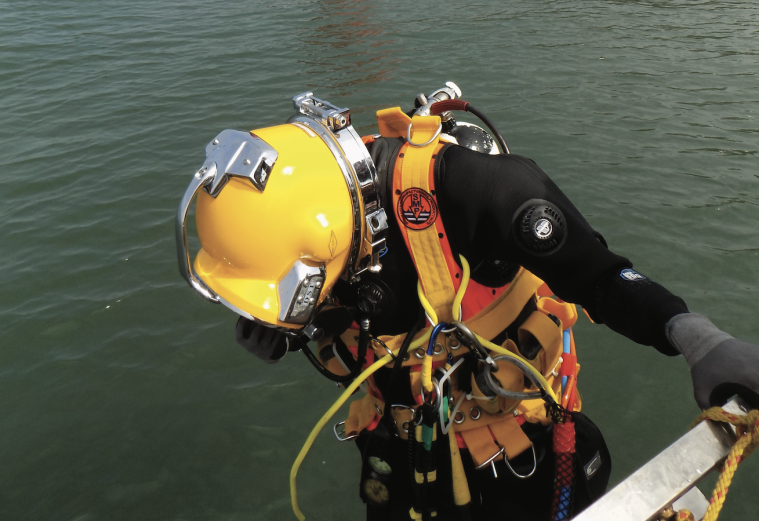
Niall Brady, Founding Co-Founding Co-Director of adco, The Archaeological Diving Company LTD, explains why working in the environment of Dublin Port has been both a pleasure and a privilege.
If you were lucky enough to get to dive in and around the shipping channels leading into Dublin Bay, there’s a chance you could find a fully intact 18th century coastal trading ship resting on the sea-bed.
Dubbed The Millstone Wreck, the ship is one of more than 300 shipwrecks in the environs of Dublin Bay since official records began in the mid-1700s, only a tiny fraction of which have been found.
“The question is ‘where are the other 280 wrecks?’” asks Niall Brady, founding director of ADCO, the Archaeological Diving Company Ltd. “The answer is
that a lot of them have left no remains, but a lot of the others have left bits and pieces of themselves in the soft sediments. When a dredger comes along and hoovers through these soft sediments, you are anticipating finding evidence of timbers and fittings from these ships that have been lost over the years, or the vessel itself has foundered and is buried in the soft sediment.”
ADCO was established in 1999 to address specific growth in the archaeological sector and the company has since expanded to include civils diving work, geotechnical investigation, and subsea environmental services. ADCO has been working with Dublin Port Company on a number of projects stretching back to 2010, including work on the Alexandra Basin Redevelopment (ABR) Project, the first phase of Masterplan 2040, which involved deepening the channel in the Port by dredging down from -7 to -10 metres, which is when Niall, his co-director Rex Bangerter and their team of maritime archaeologists found the Millstone Wreck.
The Dublin Bar
The reason dredging is required in the first place is because of the Dublin Bar, a huge sandbar that forms at the mouth of the River Liffey, which, according to Niall, “has proven to be an impediment to shipping since after the Viking period”.
“The bar builds up naturally over time with the deposition of soft sediment from the rivers, and for centuries the city was unable to tackle it,” he explains. “One solution was to stop shipping coming into the city and instead go to the deep water pools around the bay, so in the 15th century, Dalkey became an extraordinarily wealthy place because shipping could anchor in the vicinity of Dalkey Sound, and the same process happened on Lambay Island and at the Clontarf Pools. In the 18th century, the Port decided that the issue had to be addressed, as shipping was getting ever-bigger. They started the process of dredging, while work also began on the Great South Wall and then the North Bull Wall to engineer a solution whereby the channel effectively self-scours, and that solution still works today. But as shipping gets bigger and deeper, the tension between the port and the river that wants to choke itself has continued for centuries and remains the case today. The ABR capital dredging addresses the same question, and the dredgers, which are also larger, have taken the ruling depth from –7 to –10 metres.”
The dredging project unveiled timbers and furniture from a number of ships as well as the Millstone Wreck, which was carrying millstones quarried from Harrylock Quarry on Hook Head in Wexford, evidence of which is still visible today. “They would cut the millstones from exposures of old red sandstone on the foreshore, float a vessel over to them, pick them up and ship the millstones all along the East coast,” Niall reveals. “We reckon this particular ship was on her way into Dublin, foundered on the bar and was lost, but she left her cargo, which includes a series of these millstones.”
ADCO has recovered two of the millstones, as well as ship’s timbers from the vessel. But the ship itself is “still there at the toe of the navigation channel,” Niall notes.
While he “would love to see it raised”, Niall is cognisant of the challenges of raising a vessel, particularly one as old as the Millstone Wreck. “The physical lift is the straightforward part, but it becomes complicated when you consider where to put it once you lift it, and of course the vessel just wants to rot, due to the salt water, soyou have to commit to a decades-long programme of conservation and preservation.”
While internationally, some ships have been raised from the sea-bed and become symbols of national pride, like the Vasa in Stockholm or the Mary Rose in Portsmouth, the cost involved is probably prohibitively high for this “modest coastal trader”, but Niall believes that there could be some vessels that would absolutely warrant raising from the depths of Dublin Bay.
“The National Museum of Ireland, the National Monuments Service and ourselves, and the Port and the City too; we’re all waiting for the first Viking-era ship to be recovered from the active marine in Dublin. We’ve yet to find that,” he says wistfully.
Could they be out there?
“Oh yes, for sure,” he avows instantly. “Somewhere in those soft sands, there is one lurking. But they were made from timber and won’t present themselves in a way that will be found easily.”
Passion for History
Niall’s passion for his work is evident from talking to him. “I’m an archaeologist first and foremost,” he insists. “From time to time, I wander into the realms of history. A medievalist by training, Niall is a graduate of UCD and Cornell University, and his work brought his two passions, archaeology and diving, together in the 1980s, on a project that inspired his career. “In the mid-1980s, I had the opportunity to work in Ireland on the Crannóg Archaeology Project, which was run by the National Museum of Ireland and Cornell University in the Irish midlands, and was looking for the first time at these important medieval settlement sites under water.”
Working for the National Museum at the time, Niall jumped at the opportunity to dive in Lough Ennell, Co. Westmeath, and subsequently moved to New York to complete a PhD at Cornell. “I came back to Ireland 10 years later and co-founded ADCO as a specialist archaeological consultancy dealing with underwater and maritime issues with my then business partner Valerie Keeley,” explains Niall.
Changing Regulations
ADCO’s continued success is partly due to changing regulations in the 1990s, which recognised that developments on and under the water surface should be subject to the same planning requirements as developments above ground, including archaeological requirements.
“That gave us the spark to start the company,” he admits. “Developers must now meet that requirement and we are in the happy position of being willing and able to provide that service to clients like Dublin Port Company, who have been a wonderful agency to work for, with a deep understanding and appreciation of cultural heritage and a desire to do the right thing.”
Is it unusual for an entity like Dublin Port Company to have such a deep appreciation for the heritage aspects of their development work?
“It’s not unusual but what is perhaps unusual is the enthusiasm with which the Port engages with it. I’ve been at several meetings where DPC management have insisted that they wish their projects to advance through planning led by environmental issues, not hard engineering, and that really is quite an enlightened perspective on such matters. Eamonn O’Reilly (Dublin Port Company CEO) is probably quite unusual in Ireland if not further afield in this regard.”
As lead archaeologist, Niall is particularly appreciative of the Port’s Chief Engineer, Eamon McElroy, the Harbour Master’s Office and the heritage team, where Lar Joye, Heritage Director, and Jim Kelleher, Head of Special Projects, “represent a very important office within Dublin Port Company that is doing incredible and important work across the board. We are happy to make the modest contributions we can from an archaeological perspective.” He also cites Alan Barr of RPS Environmental as “another part of what is a happy team”, alongside the Port’s project management office. From the ADCO side, business partner Rex Bangerter is his right hand, while Dominick Gallagher, ADCO’s Archaeology Supervisor on site since 2016, “at this stage knows far more than I about the nuts and bolts history of Alexandra Basin and the various parties who have worked there since it was built in the 19th century”.
Archaeology on a Monumental Scale
Niall divides ADCO’s work into two areas, land and sea. “As the project archaeologists for the Alexandra Basin Redevelopment, our mission and our requirement was to look after cultural heritage matters arising from the construction programme,” he explains. “That involved a lot of monitoring the actual construction phases, whether they were on water or on land.
Any removal of current surface area needs to be monitored archaeologically, so we would watch ground disturbances and record features that emerge. On water, it is the same process. The ABR’s capital dredging programme, which is now completed, extended the ruling depth from –7 to -10 metres, which meant cutting a trench through up to three metres of previously undisturbed silt and sand, which unveiled the Millstone Wreck.”
There were also some interesting findings from the landward works on ABR, as Niall reveals: “Our expectations for what might lie under the port area of ABR before the project got underway were full of unknowns because nobody really had any history of what happened the buildings that were there. On one hand, there was a consideration that there would be nothing at all, that the demolition of the former buildings would have been complete, but what we have discovered is far from the case.”
The archaeologists were delighted to find that most of the foundations from past buildings were left intact, including the graving docks and patent slips where ships were built and repaired. “We’ve been involved in helping Dublin Port Company with the reconstitution of the area around Pumphouse No. 1 and Graving Dock No. 2.” Their work also extended to the west, in what became the P&O Yard, where “the 19th and early 20th century buildings that the old maps record but do not survive today above ground, remain largely intact at their foundation level; they’re just covered in either tarmacadam or concrete. So the Port’s history gets exposed in sections and for a period of days you will see this swathe of former Port & Docks landscape that has been buried for decades and is suddenly exposed. It is archaeology on a monumental scale.”
Even though their work on ABR is coming to a conclusion, ADCO is working with Dublin Port Company on a number of other projects, including the Liffey-Tolka Project, the restoration of the former ESB Substation on the corner of Alexandra Road and East Wall Road, and the Port’s Conservation Management Plan.
However, his love of water means that for Niall, there is nothing to compare with an underwater find. “It’s terribly exciting,” he admits. “I’ve come to think of archaeologists in the marine environment as fishermen, in that we have a good understanding of what goes on underwater and where things might be so we’re like guys with our little fly- rods out waiting for a nibble; eventually you will get one. So it is a waiting game and a lot of hard work goes into it, but when you do find something it’s a great sense of endorsement that the investment has been good and the work has achieved its ambition.”
Help us with the Archive
You can help us to preserve Dublin Port’s rich archival heritage by
donating items or seek advice from us on items in your safekeeping.
Get in touch by completing the contact form below.
We’d love to hear from you!
